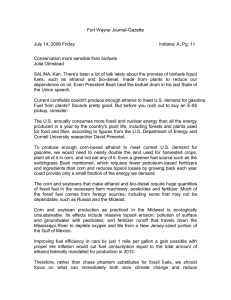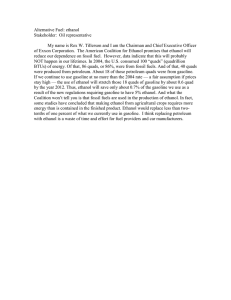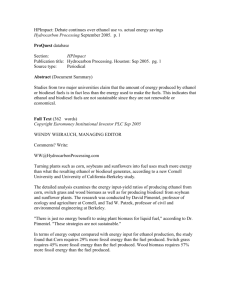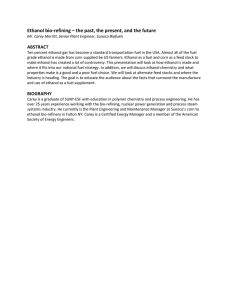The Christian Science Monitor 08-01-06
advertisement
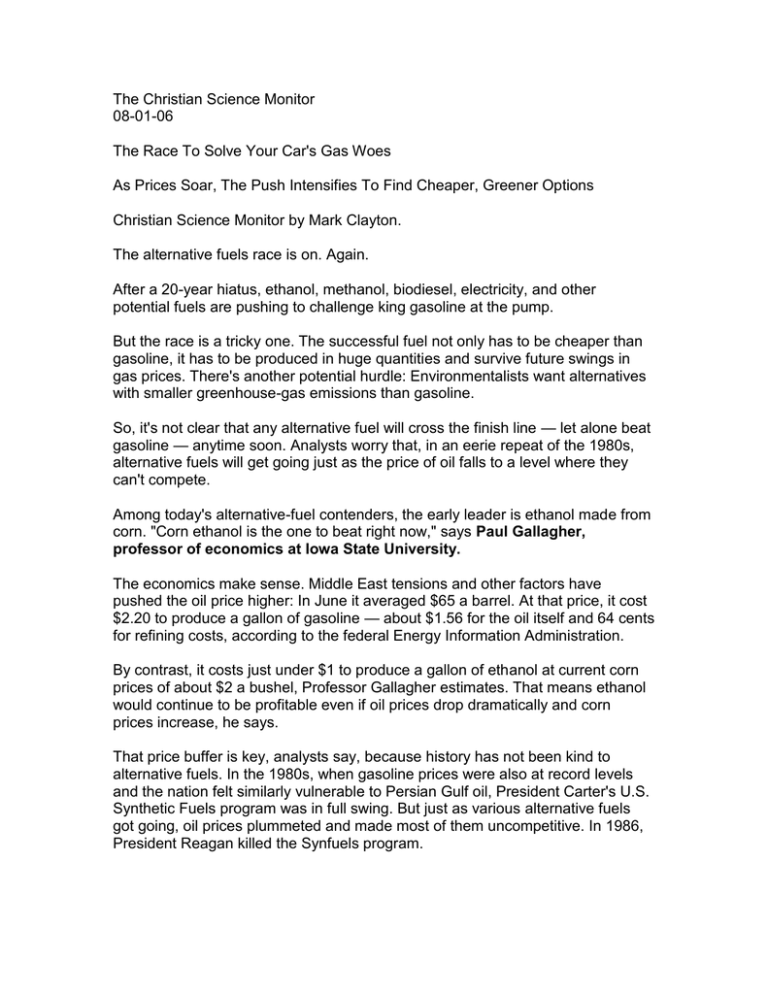
The Christian Science Monitor 08-01-06 The Race To Solve Your Car's Gas Woes As Prices Soar, The Push Intensifies To Find Cheaper, Greener Options Christian Science Monitor by Mark Clayton. The alternative fuels race is on. Again. After a 20-year hiatus, ethanol, methanol, biodiesel, electricity, and other potential fuels are pushing to challenge king gasoline at the pump. But the race is a tricky one. The successful fuel not only has to be cheaper than gasoline, it has to be produced in huge quantities and survive future swings in gas prices. There's another potential hurdle: Environmentalists want alternatives with smaller greenhouse-gas emissions than gasoline. So, it's not clear that any alternative fuel will cross the finish line — let alone beat gasoline — anytime soon. Analysts worry that, in an eerie repeat of the 1980s, alternative fuels will get going just as the price of oil falls to a level where they can't compete. Among today's alternative-fuel contenders, the early leader is ethanol made from corn. "Corn ethanol is the one to beat right now," says Paul Gallagher, professor of economics at Iowa State University. The economics make sense. Middle East tensions and other factors have pushed the oil price higher: In June it averaged $65 a barrel. At that price, it cost $2.20 to produce a gallon of gasoline — about $1.56 for the oil itself and 64 cents for refining costs, according to the federal Energy Information Administration. By contrast, it costs just under $1 to produce a gallon of ethanol at current corn prices of about $2 a bushel, Professor Gallagher estimates. That means ethanol would continue to be profitable even if oil prices drop dramatically and corn prices increase, he says. That price buffer is key, analysts say, because history has not been kind to alternative fuels. In the 1980s, when gasoline prices were also at record levels and the nation felt similarly vulnerable to Persian Gulf oil, President Carter's U.S. Synthetic Fuels program was in full swing. But just as various alternative fuels got going, oil prices plummeted and made most of them uncompetitive. In 1986, President Reagan killed the Synfuels program. But ethanol made from corn faces a supply problem. Even if the entire U.S. corn crop were devoted to producing E85 (a blend of 85 percent ethanol and 15 percent gasoline), it would supply only about 12 percent of U.S. needs, studies say. That means ethanol — if it is to succeed as a true alternative to gasoline — will have to be made of something other than corn. Other materials are being tested: corn stover, wood, wheat straw, and other organic waste. Some estimate that low-maintenance switchgrass could nearly quadruple the output of ethanol from a single acre. But turning these cellulose-based materials into ethanol hasn't been tested at a full-production scale. One Canadian pilot plant near Ottawa can make about 80 gallons of ethanol for every ton of wheat-straw refuse it uses — costing about $2 a gallon to produce, estimates Gallagher, who toured the facility recently. With a full-scale plant, the cost could drop well under the cost to make corn ethanol as efficiencies improve to 60 cents a gallon or less, a 2004 study by the Natural Resources Defense Council (NRDC) found. "I'm willing to say that ethanol from cellulose is the most promising fuel we can see today," says Nathanael Greene, an NRDC analyst. "But we can't have the idea that the search is over. We need performance-based incentives to uncover other possible fuels that may be out there." One alternative source of ethanol — sugar cane — is heavily used in Brazil. If the U.S. lowered import barriers to sugar-cane-based ethanol, the fuel could play an important role, says Gal Luft, an analyst at the Institute for the Analysis of Global Security. Another possibility: methanol made from coal, he says. Today, most methanol is made from natural gas. But because the U.S. has vast coal reserves, it should do more to promote systems that turn coal into liquid fuels, Luft says. Montana and West Virginia are among several states developing plans for such systems. In Pennsylvania, systems to turn coal waste to diesel are already under way. Methanol from coal could have a production cost of 40 to 64 cents a gallon, according to a 2003 study by the National Renewable Energy Laboratory that compared seven systems — including some developed during the U.S. synfuels heyday. The Methanol Institute, a Washington trade group, this spring pegged the fuel's wholesale cost at 76 cents a gallon. Methanol can be used directly as a fuel. Indy race cars have used it for years. Or it could be a rich source of hydrogen for fuel-cell vehicles. But there are hurdles that don't make hydrogen a near-term contender in the alternative-fuels race, including the steep cost of deploying hydrogen fueling stations nationwide and getting sufficiently cheap power to create hydrogen. Methanol is also a key part of the process of making biodiesel. Production of biodiesel — a fuel that usually blends diesel with oil made from vegetable and animal fats — has soared to 75 million gallons in 2005, according to the National Biodiesel Board. But some analysts say it will have a niche role because, as with corn ethanol, the materials to make it are limited. However, the considerable greenhouse gases released in coal-to-methanol production has environmentalists like Greene worried. Still other fuels — like compressed natural gas, used in many city buses today, liquefied natural gas, used in some trucks, or even liquid petroleum gas — have shown promise. But expanded use of these fuels would require increased imports of oil and gas, analysts say. That's a potential problem for a nation already reliant on foreign sources. Carbon-dioxide gas emissions from vehicles powered by such fuels would be lower than with gasoline, but still not eliminated, analysts point out. "I see a race between three types of fuel — ethanol from cellulose and sugar cane, methanol from coal, and electricity from the wall outlet in your garage charging up plug-in hybrid cars," Luft says. Ultimately, trends in the automotive world may be what decides the winning alternative fuel. At this stage, electricity is a strong contender. Earlier this month Toyota announced it will soon move beyond gas-electric hybrid designs to "plugin" hybrids that tap the power grid to charge their batteries and go farther on electric power alone. Using electricity to power vehicles is so efficient and cheap that, even if the juice flows from a mix of power plants including coal-fired boilers, it would still pollute less on a national basis than using gasoline, say Greene and others who have studied the issue. Driving 20 to 40 miles a day on electricity stored in a modern lithium ion battery would be like driving on gasoline costing just 75 cents per gallon, Luft says. "Electricity is cheaper, cleaner, and better performing than gasoline or any of the other fuels on every parameter," he says. "But that can only happen if manufacturers make plug-in hybrids so people can connect to the grid."


